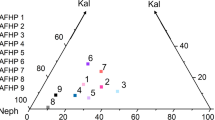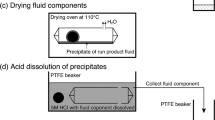Abstract
In this paper, we show that supercritical fluids have a greater significance in the generation of pegmatites, and for ore-forming processes related to granites than is usually assumed. We show that the supercritical melt or fluid is a silicate phase in which volatiles; principally H2O are completely miscible in all proportions at magmatic temperatures and pressures. This phase evolves from felsic melts and changes into hydrothermal fluids, and its unique properties are particularly important in sequestering and concentrating low abundance elements, such as metals. In our past research, we have focused on processes observed at upper crustal levels, however extensive work by us and other researchers have demonstrated that supercritical melt/fluids should be abundant in melting zones at deep-crustal levels too. We propose that these fluids may provide a connecting link between lower and upper crustal magmas, and a highly efficient transport mechanism for usually melt incompatible elements. In this paper, we explore the unique features of this fluid which allow the partitioning of various elements and compounds, potentially up to extreme levels, and may explain various features both of mineralization and the magmas that produced them.







Similar content being viewed by others
Change history
16 March 2019
In the original publication, there are some missing data in Table 1 and incorrect data in Table 2.
References
Audétat A, Keppler H (2004) Viscosity of fluids in subduction zones. Science 303:513–516
Audétat A, Li W (2017) The genesis of climax-type porphyry Mo deposits: insight from fluid inclusions and melt inclusions. Ore Geol Rev 88:436–460
Audétat A, Pettke T (2003) The magmatic-hydrothermal evolution of two barren granites: a melt and fluid inclusion study of the Rito del Medio and Canada Pinabete Plutons in northern New Mexico (USA). Geochim Cosmochim Acta 67:97–121
Bolmatov D, Brazhkin VV, Trachenko K (2013) Thermodynamic behaviour of supercritical matter. Nat Commun 4:2331. https://doi.org/10.1038/ncomms3331
Borisova AY, Thomas R, Salvi S, Candaudap F, Lanzanova A, Chemleff J (2012) Tin and associated metal and metalloid geochemistry by femtosecond LA-ICP-QMS microanalysis of pegmatite-leucogranite melt and fluid inclusions: new evidence for melt-melt-fluid immiscibility. Mineral Mag 76:91–113
Bureau H, Keppler H (1999) Complete miscibility between silicate melts and hydrous fluids in the upper mantle: experimental evidence and geochemical implications. Earth Planet Sci Lett 165:187–196 (35)
Bureau H, Ménez B, Malavergne V, Somogyi A, Simionovici A, Massare D, Khodja H, Daudin L, Gallien J-P, Shaw C, Bonnin-Mosbah M (2007) In situ mapping of high-pressure fluids using hydrothermal diamond anvil cells. High Press Res Int J 27(2):235–247. https://doi.org/10.1080/08957950701384572
Candela PA (1997) A review of shallow, ore-related granites: textures, volatiles, and ore metals. J Pet 38:1619–1633
Carten RB, Geraghty EP, Walker BM, Shannon JR (1988) Cyclic development of igneous features and their relationship to high-temperature hydrothermal features in the Henderson porphyry molybdenum deposit, Colorado. Econ Geol 83:266–296
Cloos M (2001) Bubbling magma chambers, cupolas, and porphyry copper deposits. Int Geol Rev 43(4):285–311
Core DP, Kesler SE, Essene EJ (2006) Unusually Cu-rich magmas associated with giant porphyry copper deposits: evidence from Bingham. Utah Geol 34(1):41–44
Dietrich A, Lehmann B, Wallianos A (2000) Bulk rock and melt inclusion geochemistry of Bolivian tin porphyry systems. Econ Geol 95:33–326
Goranson RW (1931) The solubility of water in granite magmas. Am J Sci 22:481–502
Gorbaty YE, Bondarenko GV (1998) The physical state of supercritical fluids. J Supercrit Fluids 14:1–8
Hollas MJ (1996) Modern spectroscopy, 3rd edn. Wiley, New York, pp 30–34. ISBN: 0471965227
Kamenetsky VS, van Achterbergh E, Ryan CG, Naumov VB, Mernagh TP, Davidson P (2002) Extreme chemical heterogeneity of granite-derived hydrothermal fluids: an example from inclusions in a single crystal of miarolitic quartz. Geology 30:459–462
Kawamoto T, Mibe K, Bureau H, Reguer S, Mocuta C, Kubsky S, Thiaudière D, Ono S, Kogiso T (2014) Large-ion lithophile elements delivered by saline fluids to the sub-arc mantle. Earth Planets Space 66:61
Korzhinsky MA, Tkachenko SI, Shmulovich KI, Taran YA, Steinberg GS (1994) Discovery of a pure rhenium mineral at Kudriavy volcano. Nature 369(6475):51–52
London D, Evensen JM (2002) Beryllium in silicic magmas and the origin of beryl-bearing pegmatites In: Grew ES (ed) Beryllium: mineralogy, petrology, and geochemistry. Rev Miner Geochem 50:445–486
Manning CE (1994) The solubility of quartz in H2O in the lower crust and upper mantle. Geochim Cosmochim Acta 58(22):4831–4839
Manning CE (2004) The chemistry of subduction-zone fluids. Earth Planet Sci Lett 223:1–16
Manning CE (2006) What’s so super about supercritical fluids in subduction zones? Geochim Cosmochim Acta 70(18):A38
Michal J (1973) Inorganic chromatographic analysis. Van Nostrand Reinhold Co, London
Müller A, Husdal T, Sunde Ø, Friis H, Andersen T, Johansen TS, Werner R, Thoresen Ø, Olerud S (2017) Norwegian Pegmatites I: Tysfjord-Hamarøy, Evje-Iveland, Langesundsfjord. Excursion Guide NGF Series 2017-6
Mutschler FE, Wright EG, Ludington S, Abbott JT (1981) Granite molybdenite systems. Econ Geol 76:874–897
Mysen B (2014) Water-melt interaction in hydrous magmatic systems at high temperature and pressure. Prog Earth Planet Sci 1:4
Ni H, Zhang L, Xiong X, Mao Z, Wang J (2017) Supercritical fluids at subduction zones: evidence, formation condition, and physicochemical properties. Earth Sci Rev 167:62–71
Peach G (1981) Theory of the pressure broadening and shift of spectral lines. Adv Phys 30(3):367–474
Peretyazhko IS, Smirnov SZ, Thomas VG, Zagorsky VY (2004) Gels and melt-like gels in high-temperature endogeneous mineral formation. In: Proceedings of the interim IAGOD conference Vladivistok/Russia, Vladivostok Dalnauka, pp 306–309
Pioro I, Mokry S (2011) Thermophysical properties at critical and supercritical pressures. In: Belmiloudi A (ed) Heat transfer—theoretical analysis, experimental investigations and industrial systems. InTec, Rijeka
Rickers K, Thomas R, Heinrich W (2004) Trace element analysis of individual synthetic and natural fluid inclusions with synchrotron radiation XRF using Monte Carlo simulation for quantification. Eur J Mineral 16:23–35
Rickers K, Thomas R, Heinrich W (2006) The chemical evolution of a water-, B- and F-rich granite-pegmatite system related to a Sn-W mineralization: a melt/fluid inclusion study. Miner Depos 41:229–245
Rösler HJ, Lange H (1975) Geochemische Tabellen. VEB Deutscher Verlag, Leipzig
Schmidt C, Wohlers A, Marquardt K, Watenphul A (2014) Experimental study on the pseudobinary H2O + NaAlSi3O8 at 600–800 °C and 0.3–2.4 GPa. Chem Geol 388:40–47
Shinohara H, Kazahaya K, Lowenstern JB (1995) Volatile transport in a convecting magma column: implications for porphyry Mo mineralisation. Geology 23(12):1091–1094
Smirnov SZ (2015) The fluid regime during the magmatic evolution of rare-metal, fluorine- and boron-rich granite-pegmatite systems: petrogenetic conclusions. DSc Dissertation, Novosibirsk (in Russian)
Smith FG (1948) Transport and deposition of the non-sulphide vein minerals. III, Phase relations at the pegmatite stage. Econ Geol 43:535–546
Sowerby J, Keppler H (2002) The effect of fluorine, boron and excess sodium on the critical curve in the albite-H2O system. Contrib Miner Pet 143:32–37
Thomas R, Davidson P (2010) Hambergite-rich melt inclusions in morganite crystals from the Muiane pegmatite, Mozambique and some remarks on the paragenesis of hambergite. Mineral Pet 100:227–239
Thomas R, Davidson P (2013) The missing link between granites and granitic pegmatites. J Geosci 58:183–200
Thomas R, Davidson P (2016a) Revisiting complete miscibility between silicate melts and hydrous fluids, and the extreme enrichment of some elements in the supercritical state—consequences for the formation of pegmatites and ore deposits. Ore Geol Rev 72:1088–1101
Thomas R, Davidson P (2016b) Origin of miarolitic pegmatites in the Königshain granite/Lusatia. Lithos 260:225–241
Thomas R, Davidson P, Beurlen H (2012) The competing models for the origin and internal evolution of granitic pegmatites in the light of melt and fluid inclusion research. Mineral Pet 106:55–73
Thomas R, Webster JD, Heinrich W (2000) Melt inclusions in pegmatite quartz: complete miscibility between silicate melts and hydrous fluids at low pressure. Contrib Miner Pet 139:394–401
Thomas R, Förster H-J, Rickers K, Webster JD (2005) Formation of extremely F-rich hydrous melt fractions and hydrothermal fluids during differentiation of highly evolved tin-granite magmas: a melt/fluid-inclusion study. Contrib Miner Pet 148:582–601
Thomas R, Rericha A, Pohl WL, Davidson P (2018) Genetic significance of the 867 cm−1 out-of-plane Raman mode in graphite associated with V-bearing green grossular. Mineral Pet. https://doi.org/10.1007/s00710-018-0563-1
Veksler IV, Thomas R, Schmidt C (2002) Experimental evidence of three coexisting immiscible fluids in synthetic granitic pegmatite. Am Miner 87:775–779
Vogel R (1959) Die heterogenen Gleichgewichte. Akademische Verlagsgesellschaft, Leipzig
Webster JD, Thomas R, Rhede D, Förster H-J, Seltmann R (1997) Melt inclusions in quartz from evolved peraluminous pegmatite: geochemical evidence for strong tin enrichment in fluorine-rich and phosphorus-rich residual liquids. Geochim Cosmochim Acta 61:2589–2604
Wilkinson JJ, Nolan J, Rankin AH (1996) Silicothermal fluid; a novel medium for mass transport in the lithosphere. Geology 24(12):1059–1062
Acknowledgements
We would like to take this opportunity to dedicate this paper to Dr. James Webster, with our thanks and gratitude for his unflagging assistance, collaboration and encouragement over the years. Over a long period, Dr. Webster has worked with us unravelling the mysteries of melt–melt immiscibility, in addition to the enormous body of work he has achieved in other areas of geology and geochemistry. We thank Prof. Huaiwei Ni for valuable suggestions and the hint to some important references.
Author information
Authors and Affiliations
Corresponding author
Ethics declarations
Conflict of interest
The authors declare that they have no conflict of interest.
Electronic supplementary material
Below is the link to the electronic supplementary material.
Rights and permissions
About this article
Cite this article
Thomas, R., Davidson, P. & Appel, K. The enhanced element enrichment in the supercritical states of granite–pegmatite systems. Acta Geochim 38, 335–349 (2019). https://doi.org/10.1007/s11631-019-00319-z
Received:
Revised:
Accepted:
Published:
Issue Date:
DOI: https://doi.org/10.1007/s11631-019-00319-z




